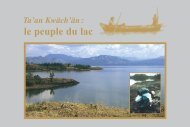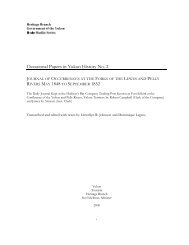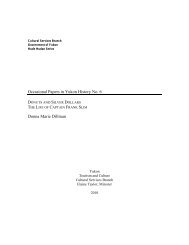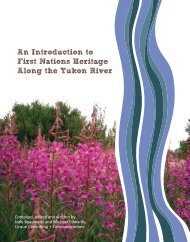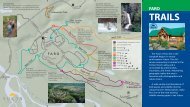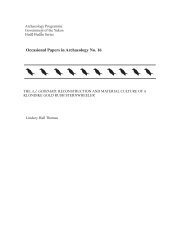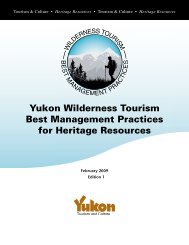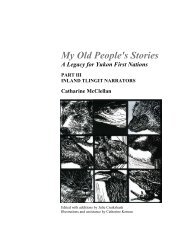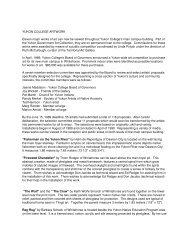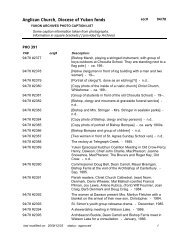Sustainable Tourism: The Tour Operators' Contribution
Sustainable Tourism: The Tour Operators' Contribution
Sustainable Tourism: The Tour Operators' Contribution
You also want an ePaper? Increase the reach of your titles
YUMPU automatically turns print PDFs into web optimized ePapers that Google loves.
6.3 Travel Walji’s:<br />
Contributing to the Local Economy<br />
in the Karakorum Region<br />
Description of Good Practice<br />
As part of a policy that calls for preservation of traditional culture and the<br />
local environment, promotion of local art and handicrafts, and encouragement<br />
of local inhabitants to be self-sufficient, Travel Walji’s (Private)<br />
Limited, Pakistan’s largest inbound tour operator, supports local entrepreneurs in Karimbad, in the<br />
Karakorum region of Pakistan (see Box 1). Travel Walji’s (TWL) is the first tour operator to organise tours<br />
to this area.<br />
TWL has provided the following support:<br />
• Interest-free loans to build hotels;<br />
• Taking tourists to visit the Handicraft Development Project that now provides jobs and extra income for<br />
many local people;<br />
• Guide training conducted in collaboration with the Town Management Society for Karimabad, a group<br />
that seeks to protect the physical and cultural environment of Karimabad;<br />
• <strong>The</strong> development of tourism in the region, which has increased demand for cultural shows and thus<br />
helped revive local music and traditional activities such as sword dancing; and<br />
• <strong>The</strong> hiring of guides, assistant managers, drivers and trekking guides from the Hunza Valley, the wider<br />
region that includes Karakorum.<br />
Box 1: <strong>The</strong> Hunza Valley<br />
<strong>The</strong> Hunza Valley, in northern Pakistan<br />
close to the border with China, is part<br />
of the dramatic terrain of the Karakorum<br />
Mountain Range. Until the late 1960s,<br />
there was no access to the region, and<br />
trekking overland on foot from Gilgit took<br />
up to four days. In 1974, the Hunza valley<br />
was annexed to Pakistan and, over the<br />
next 11 years, the Pakistani Government,<br />
with support from the Chinese, built the<br />
Karakorum Highway, a 750-km (466-mile)<br />
road that runs along the old Silk Road up<br />
to the Chinese border.<br />
Implementation<br />
Although the region is now easily accessible, until TWL<br />
provided support to the region, most Hunzakurts were living<br />
below subsistence level, with many young people leaving<br />
the area for cities such as Islamabad, Lahore and Karachi.<br />
TWL has used local transport and brought in its own buses,<br />
vans, cars and jeeps to encourage economic growth. <strong>The</strong><br />
company has also worked with other institutional donors<br />
working in the area, in particular the Aga Khan Trust for<br />
Culture (see Box 2).<br />
Benefits<br />
About 30 percent of TWL’s tourists going to and from China<br />
through the Khunjrab Pass now visit Karimabad, which was<br />
the ancient seat of the Mir (the ruler) of the Hunza Valley,<br />
and the 700-year-old Baltit Fort, located at the top of a natural amphitheatre formed by terraced slopes.<br />
<strong>The</strong> visitors purchase local handicrafts, watch traditional Hunza dance and listen to traditional Hunza<br />
music.<br />
As a result of the activities of TWL and other donors:<br />
• <strong>The</strong>re are now 27 shops selling handicrafts, trekking equipment, food, postcards, local embroidery,<br />
carpets and gems. Traders have set up an organised Bazaar committee as a registered society;<br />
• <strong>The</strong> restored Baltit Fort earns direct revenues of about US $50,000 from the sale of tickets to foreign<br />
tourists and indirect revenues of about US$ 200,000, benefiting central Hunza;<br />
• By mobilizing local handicraft production through the Karakoram Handicraft Development Programme,<br />
<strong>Sustainable</strong> <strong><strong>Tour</strong>ism</strong>: <strong>The</strong> <strong>Tour</strong> Operators’ <strong>Contribution</strong><br />
6. Cooperation with Destinations




